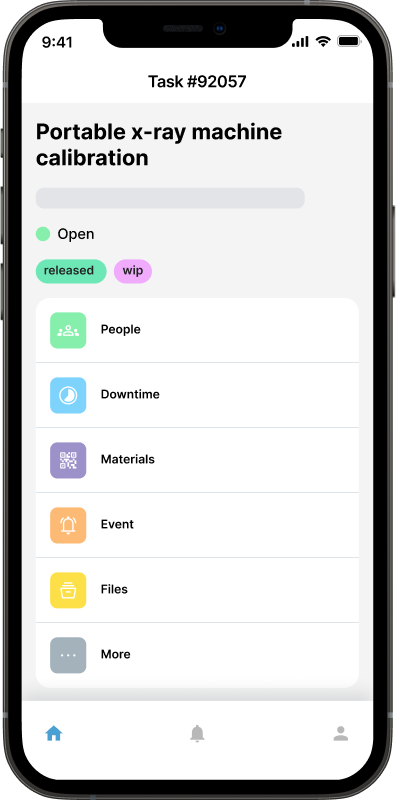Budgeting & ROI: Calculating the Financial Benefits of CMMS Implementation

Whether you’re maintaining manufacturing equipment, facilities, fleets, hotels or property assets, the way you maintain them directly affects productivity, safety, and profitability. Yet one of the most common questions we hear from maintenance leaders is "How do I justify the cost of CMMS as an essential tool?"
At Maintainly, we understand that investing in new software is a big decision. You need to show clear financial value, measurable results, and a strong return on investment (ROI). The good news? A modern CMMS almost always pays for itself and often faster than expected.
In this blog post, we break down how budgeting for a CMMS works, how to calculate ROI, and what financial benefits you can expect once your system is up and running.
Why CMMS ROI Matters More Than Ever?

Many teams still rely on spreadsheets, paper files, or outdated systems that are slow, unreliable, or simply not designed for today’s demands. It results in:
Unnecessary downtime - Because failures aren’t tracked or predicted, equipment ends up offline longer than it should.
Increasing reactive repairs
Maintenance teams get stuck responding to breakdowns instead of preventing them, which creates a costly cycle of urgency.Higher labour costs - Technicians waste time searching for information, repeating tasks, or dealing with avoidable issues.
No real visibility into maintenance data - Without accurate records, managers can’t see trends, performance, or the true cost of running assets.
Poor planning and zero forecasting - Teams can’t prepare for upcoming maintenance or budget accurately, leading to constant surprises.
Missed warranty claims - Lack of documentation means equipment gets repaired out-of-pocket when a warranty could’ve covered it.
Overspending on parts and emergency purchases - Inventory isn’t tracked properly, causing rush orders, overstocking, or running out of critical parts.
A CMMS turns all of this around by creating structure, efficiency, and preventative workflows. But the real story is in the numbers.
Understanding the Cost of CMMS Implementation
Budgeting for a CMMS usually involves a few key cost categories:
1. Software Subscription
Most modern CMMS platforms use a monthly or annual subscription model.
Pricing often depends on:
Number of users - More users typically increase the subscription tier, as it reflects how broadly the system is deployed.
Number of assets - Large asset counts require more data storage and functionality, which can raise the pricing level.
Features (mobile access, automation, reporting, integrations, etc.) - Advanced capabilities often come in higher plans because they deliver more value and require more infrastructure.
2. Onboarding & Setup
This can include:
System configuration - Tailoring the system so it matches your workflows, equipment types, and internal processes.
Asset data imports - Transferring existing records into the CMMS to ensure a clean, accurate starting point.
User training - Teaching the team how to use the system so adoption is fast and smooth.
Workflow setup - Building preventive maintenance schedules and approval paths that support daily operations.
With Maintainly, we keep onboarding simple and intuitive to reduce both costs and learning time.
3. Optional Add-Ons
Depending on your needs:
Sensors or IoT integrations - These automate condition monitoring so maintenance becomes predictive rather than reactive.
API connectors - Integrations let your CMMS talk to other business systems, reducing double-handling of data.
Advanced reporting modules - Sophisticated analytics can unlock deeper insights into asset performance and spend.
4. Time Investment
This is often overlooked.
Teams need time to:
Audit assets - Understanding what you have and capturing the right details ensures accurate maintenance planning.
Enter data - Setting up asset records, parts lists, and schedules is essential for long-term automation.
Learn the system - A short learning curve upfront means greater efficiency and fewer errors later.
But this time investment pays off quickly once the CMMS starts saving hours every week.
What Most Organisations Discover?
Even for small to mid-size teams, CMMS costs are modest compared to the savings generated in the first year.
The Financial Benefits of Implementing a CMMS
Here’s where ROI becomes clear. A CMMS delivers savings in several measurable areas.
1. Reduced Equipment Downtime
Unplanned downtime is one of the most expensive consequences of poor maintenance.
A CMMS helps teams shift from reactive to proactive, preventing breakdowns before they happen.
Financial impact:
Fewer interruptions to production or operations - When equipment stays running, output remains consistent, and revenue isn’t disrupted.
Less overtime required - Technicians spend fewer nights and weekends fixing preventable failures.
Fewer emergency repairs - Breakdowns become rare, meaning fewer costly last-minute service calls.
Longer asset lifespan - Preventive care slows wear and tear, extending the useful life of critical equipment.
Even a 10–20% reduction in downtime often pays for the entire CMMS subscription.
2. Lower Labour Costs
A CMMS improves efficiency across the entire team by:
Automating work orders - Tasks are assigned instantly with clear instructions, reducing coordination time.
Standardising workflows - Everyone follows the same process, which eliminates confusion and repetitive work.
Reducing admin time - Less time is spent filling out paperwork or updating spreadsheets.
Prioritising high-impact tasks - Technicians focus on the jobs that matter most instead of low-value busywork.
Enabling faster technician response - Real-time notifications help teams address issues early, before they escalate.
Maintenance teams commonly recover 5–8 hours per employee per week.
Those reclaimed hours translate directly into saved labour dollars.
3. Better Inventory & Parts Management

Without a CMMS, parts management often looks like:
Missing inventory - Teams waste time searching for items that aren’t actually in stock.
Overstocking “just in case” - Money gets tied up in parts that sit unused on shelves.
Wasted storage space - Excess inventory eats up valuable room that could be better utilised.
Emergency purchases at premium prices - Rush orders and same-day deliveries drive up costs.
With a CMMS:
You know the exact stock levels - Real-time visibility eliminates guesswork and surprises.
You prevent duplicate orders - Teams avoid reordering items already sitting on the shelf.
You avoid rush fees - Scheduled maintenance lets you buy parts ahead of time at normal rates.
You track vendor pricing - This helps you negotiate better deals and spot cost increases early.
You reduce overall inventory carrying costs - Optimised stock levels free up cash and reduce storage waste.
Over a year, many organisations save thousands just by tightening inventory control.
4. Longer Asset Lifespan
Preventative maintenance is cheaper than:
Breakdowns - Emergency fixes are always more expensive than routine servicing.
Replacements - Keeping equipment healthy means delaying costly capital purchases.
Emergency service calls - Last-minute technicians come at premium rates.
When equipment is maintained regularly, its lifespan increases; sometimes by years.
This adds major ROI because asset replacement is one of the most significant expenses in any organisation.
5. Better Compliance & Fewer Safety Risks
A CMMS helps maintain audit trails, follow regulations, complete safety inspections, and prove compliance. Avoiding fines or safety incidents is a massive financial benefit.
6. Data-Driven Decision-Making
A CMMS provides:
Cost reports - You can instantly see where money is being spent and why.
Work order history - Patterns reveal recurring issues that need attention.
Asset performance insights - Leaders can identify which equipment is performing well, and which isn’t.
Failure pattern tracking - Repeated failures become easy to spot and address proactively.
Technician productivity stats - You gain visibility into workload, response times, and efficiency.
This data helps leaders:
Improve budgets - Forecasting becomes more accurate and defensible.
Justify staffing decisions - You can clearly show whether the team is under-resourced or over-extended.
Predict repair vs replace timing - Data eliminates guesswork and prevents premature replacements
.
Identify top cost drivers - You can focus improvement efforts where they deliver the highest ROI.
And, we all know, better decisions equal better financial outcomes.
How to Calculate ROI for a CMMS?
Here’s a simple formula you can use:
ROI = (Financial Gain – Cost of Investment) ÷ Cost of Investment × 100
To calculate financial gain, you can measure savings in areas like reduced downtime, lower labor hours, reduced emergency repairs, lower inventory waste, and reduced admin time.
Example Scenario: Mid-Sized Facility
Before CMMS:
20 hours of downtime/month costing $800/hr = $16,000/month
Emergency repairs = $3,000/month
Admin time for paperwork = $2,000/month
Inventory waste = $1,000/month
Total inefficiency cost: $22,000/month
After CMMS implementation:
Downtime reduced by 25% = $4,000 saved
Emergency repairs drop by 50% = $1,500 saved
Admin time drops in half = $1,000 saved
Inventory waste reduced = $500 saved
Total savings per month: $7,000
If the CMMS costs $1,000/month:
ROI = ($7,000 – $1,000) ÷ $1,000 × 100 = 600%
A 600% return is not unusual, as many teams experience similar results.
When You’ll Start Seeing ROI
Most organisations start seeing measurable ROI within:
30 days (reduced admin time)
60–90 days (better workflow structure)
6 months (lower downtime & cost savings)
12 months (full financial impact & improved forecasting)
For many Maintainly clients, the system pays for itself in less than three months.
Budgeting Tips for a Successful CMMS Rollout
1. Start with Your Pain Points. Identify your biggest cost drivers: downtime, labor, replacement tasks, and inventory problems. This helps set clear expectations for ROI.
2. Map Out Your Assets: A simple inventory of equipment, parts, and locations makes CMMS setup faster and more accurate.
3. Involve Your Technicians Early: They know the pain points better than anyone.
4. Start Small, Then Scale: You don’t need every feature on day one. Start with the essentials, then build up.
5. Track Progress from Day One: Measure work order volume, time to completion, downtime hours, emergency spend, and PM compliance. These metrics prove financial value quickly.
What are you waiting for?
When evaluating a CMMS, the price doesn’t tell the full story; the savings do.
At Maintainly, we’ve seen organisations of all sizes transform their operations with better visibility, smoother workflows, and smarter planning. The shift from reactive to proactive maintenance creates financial stability, operational confidence, and long-term growth.
If you’re looking to reduce costs, extend asset life, and maximize your team’s efficiency, a CMMS is essential. Try our advanced CMMS today for free.

